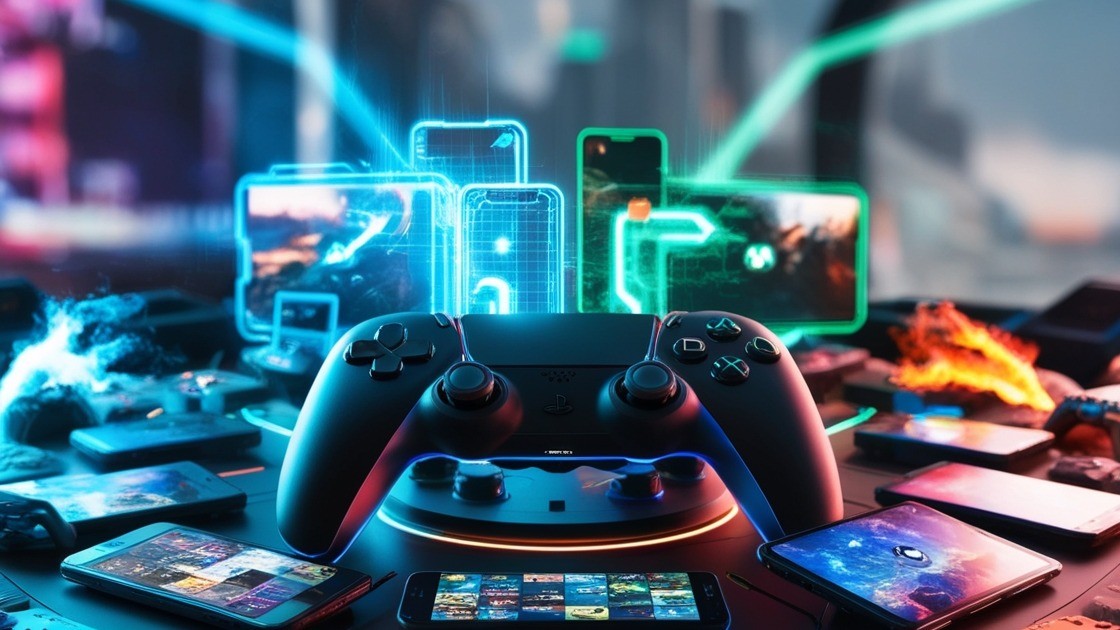The gaming industry has always been at the forefront of technological innovation, constantly pushing the boundaries of what’s possible in interactive entertainment. In 2025, advancements in game technology are set to transform the way we play, experience, and interact with digital worlds. From immersive virtual reality to blockchain-based economies, these innovations promise to redefine gaming for millions of players worldwide. This article explores the latest trends and breakthroughs in game technology and examines how they are shaping the future of the industry.
2. Advancements in Immersive Technologies
2.1 Virtual Reality (VR) and Augmented Reality (AR)
Virtual Reality and Augmented Reality continue to revolutionize the gaming experience:
-
Enhanced Immersion: Modern VR headsets now offer higher resolutions, wider fields of view, and improved motion tracking, creating truly immersive virtual worlds.
-
Seamless Integration: AR technology overlays digital elements onto the real world, transforming everyday environments into interactive gaming landscapes.
-
Expanding Applications: Beyond entertainment, VR and AR are increasingly used in educational, training, and simulation applications, blurring the lines between gaming and real-life experiences.
2.2 Mixed Reality and Haptic Feedback
Emerging mixed reality (MR) technologies are combining the best of VR and AR:
-
Real-World Interactions: MR allows players to interact with both physical and virtual elements, opening up new gameplay possibilities.
-
Haptic Feedback: Advanced haptic systems provide tactile sensations that mimic real-world textures and forces, adding another layer of immersion to gameplay.
3. Cloud Gaming and 5G Connectivity
3.1 The Rise of Cloud Gaming
Cloud gaming is set to transform the way games are delivered and played:
-
No Hardware Limitations: By offloading processing to remote servers, cloud gaming enables players to access graphically intensive games on devices without high-end hardware.
-
Instant Access: Players can stream games instantly without lengthy downloads or updates, making it easier than ever to jump into the action.
-
Cross-Platform Experiences: Cloud gaming services are bridging the gap between mobile, PC, and console gaming, offering a unified ecosystem that enhances accessibility.
3.2 The Impact of 5G Networks
The rollout of 5G technology is a game changer for online gaming:
-
Reduced Latency: 5G’s low-latency connections allow for near-instantaneous responses, which is critical for fast-paced, competitive gameplay.
-
Enhanced Streaming: With faster data speeds, 5G enables high-quality game streaming and real-time interactions, making cloud gaming a viable option for mainstream gamers.
-
Global Connectivity: The widespread adoption of 5G is set to expand the gaming market, allowing players from remote regions to access premium gaming experiences.
4. Blockchain and NFT Integration
4.1 Redefining Digital Ownership
Blockchain technology is increasingly being integrated into gaming:
-
NFTs in Gaming: Non-fungible tokens (NFTs) allow players to own unique digital assets, from rare skins to exclusive in-game items. This creates a new dimension of value and scarcity in virtual economies.
-
Secure Transactions: Blockchain provides a transparent and secure framework for in-game transactions, ensuring that players’ assets are protected from fraud and unauthorized duplication.
-
Innovative Monetization: The integration of blockchain opens up new monetization models such as play-to-earn, where players can earn real-world value through their in-game achievements.
4.2 Creating Sustainable Gaming Economies
Blockchain technology has the potential to transform game economies:
Advestisment
-
Decentralized Marketplaces: Players can trade NFTs and digital assets on decentralized platforms, giving them greater control over their virtual collections.
-
Incentivized Engagement: By rewarding players for their time and creativity, blockchain-based systems encourage deeper engagement and foster a more vibrant community.
5. The Future of AI in Gaming
5.1 Smarter NPCs and Dynamic Worlds
Artificial Intelligence is reshaping game design:
-
Adaptive NPCs: Advanced AI algorithms create non-player characters (NPCs) with dynamic behaviors that adapt to player actions, making virtual worlds feel more responsive and alive.
-
Procedural Generation: AI is used to generate expansive, diverse game environments and narratives, offering endless replayability and personalized experiences.
-
Enhanced Game Balancing: Data-driven AI helps developers analyze gameplay and fine-tune game mechanics, ensuring balanced and engaging experiences for all players.
5.2 Personalized Gaming Experiences
AI is paving the way for highly customized gameplay:
-
Behavioral Analysis: Machine learning algorithms analyze individual player habits to adjust difficulty levels and suggest personalized in-game content.
-
Predictive Analytics: By forecasting player actions, AI can optimize game performance and provide real-time recommendations, ensuring a smoother gaming experience.
-
Interactive Storytelling: AI-driven narratives adjust based on player decisions, creating a unique storyline that evolves with each playthrough.
6. Industry Impact and Market Trends
6.1 Economic Growth and Investment
The rapid evolution of game technology is fueling economic growth:
-
Increased Investment: Major tech companies and venture capitalists are investing heavily in innovative game technologies, driving further advancements in the industry.
-
Job Creation: The demand for skilled professionals in areas such as game development, AI, VR/AR, and blockchain is on the rise, creating new career opportunities.
-
Global Market Expansion: With technological advancements making high-quality gaming more accessible, the global gaming market is set to grow, reaching new demographics and regions.
6.2 Shifting Consumer Expectations
Players today expect more from their gaming experiences:
-
Immersive Experiences: As technology advances, gamers demand richer, more immersive experiences that combine realistic graphics, dynamic audio, and interactive gameplay.
-
Seamless Integration: The convergence of various technologies (5G, cloud gaming, AI) is driving the demand for seamless, cross-platform experiences that allow players to access games anytime, anywhere.
-
Community and Social Interaction: Modern gamers seek social connectivity, making community-driven content and interactive multiplayer experiences a vital component of the gaming ecosystem..
7. Conclusion
The future of game technology in 2025 is set to be defined by unprecedented innovations and rapid technological advancements. From VR and AR that offer immersive experiences to cloud gaming that breaks down hardware barriers, the landscape of gaming is evolving at a remarkable pace. Blockchain and NFTs are transforming digital ownership and economies, while AI personalizes and enhances gameplay like never before.
For gamers and developers alike, these emerging trends present both exciting opportunities and significant challenges. As the industry continues to grow, the fusion of these technologies will create a more interconnected, immersive, and dynamic gaming ecosystem that promises to redefine the very nature of interactive entertainment.
Stay tuned to industry updates and embrace the innovations shaping the future of game technology—where every new advancement brings us one step closer to experiencing truly limitless virtual worlds.


